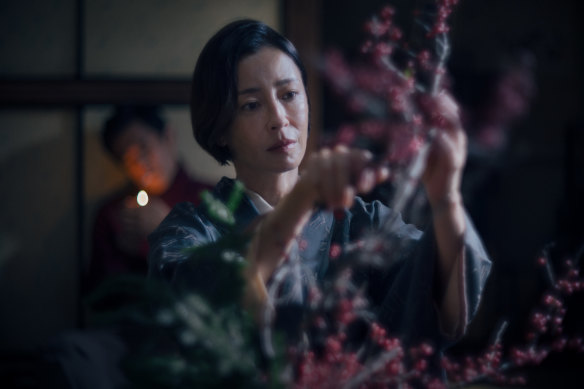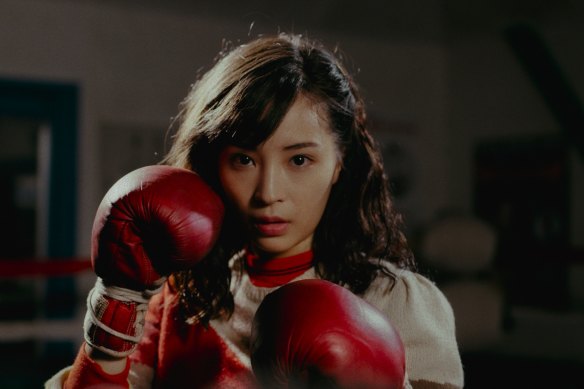
Asura
Netflix
★★★★½
Of all the cinema’s leading directors who’ve put their imprint on a streaming series, the most low-key but consistent crossover has come from revered Japanese filmmaker Hirokazu Kore-eda. Two years ago this month, the Cannes Palme d’Or winner oversaw the terrific coming-of-age tale The Makanai: Cooking for the Maiko House for Netflix, and now Kore-eda has returned with the masterful Asura, the first must-see show of 2025.
Set in 1979 Tokyo, with Kore-eda writing and directing each of the seven episodes, Asura is centred on the touchstone of his storytelling: the ever-changing family unit. The most subtle of auteurs, Kore-eda sees familial bonds as a defining force and an ineffable mystery. It certainly applies to the four adult daughters of the Takezawa household, who are assembled one evening by the most serious of the quartet, Takiko (Yu Aoi), and presented with photographic evidence that their 70-year-old father, Kotaro (Jun Kunimura), has a long-standing mistress.

Asura is based on the Kuniko Mukoda novel Ashura no Gotoku and the author’s screenplay for a 1979 Japanese broadcast television series of the same name.Credit:
The four women are deeply bonded, but each reacts differently. Takiko wants to intervene, nominally for the sake of their mother, Fuji (Keiko Matsuzaka), while the oldest sister, the widowed Tsunako (Rie Miyazawa), has her own secrets that leave her hesitant to be involved. The night’s host, Makiko (Machiko Ono), is quietly devastated, as she fears her own husband, Takao (Masahiro Motoki), will follow the same path. The youngest, Sakiko (Suzu Hirose), is blasé, as her primary goal is to annoy Takiko.
Asura arches out from this striking starting point, making full use of the extended running time to follow various plotlines while capturing with unadorned intimacy the dynamics that govern the clan. The tender, telling detail starts with the way the four sisters work as a lifelong unit when they’re together, while they joke and debate or reminisce and share truths. The overlapping dialogue and living space choreography achieve a naturalistic hum, right down to an exasperated Takiko eventually whacking Sakiko.
The show is adapted from both the Kuniko Mukoda novel Ashura no Gotoku and the author’s own screenplay for a 1979 Japanese broadcast television series of the same name. Kore-eda, who turned 17 in 1979, treats the characters with historic intent. They view their father’s actions, and then each other’s, through a period viewpoint. When Makiko offers a catch-all excuse for her father’s infidelity – “Dad’s a guy after all” – no one objects. The women’s tolerance of male failings will be jarring for some viewers.

The series is set in 1979 Tokyo and focuses on the four adult daughters of the Takezawa household.Credit:
Kore-eda uses all the tools of a traditional family drama, from everyone being thrown together after a family member is unexpectedly hospitalised to unexpected emotional entanglements. But the plot is never overwhelming; it ebbs and flows with a deeply lived-in feel that’s matched by the cusp of the 1980s production design. The characters’ actions are simply part of their day-to-day, even if that means Takiko’s courtship by the private detective she hired, Shizuo Katsumata (Ryuhei Matsuda), has a bittersweet eccentricity.
For foreign audiences, the show’s illuminating details, such as the daughters discovering the erotic illustration that once served as sex education for their newly married mother, have an almost anthropological texture. The family members reveal themselves to each other in ways the onlooker never expected, and the circle keeps expanding. Watch how Makiko’s teenage daughter goes from eavesdropping on her mother and aunts to publicly defining herself.
Loading
The result is a show that is both expansive and deeply held. It fits in seamlessly with Kore-eda’s movies, allowing for moments of sublime transcendence. When Tsunako lies on the floor, surrounded by family keepsakes, the camera shoots her from above in a God’s-eye shot that keeps rising as if the ceiling were suddenly not there. No one blows the roof off as quietly as Hirokazu Kore-eda.



